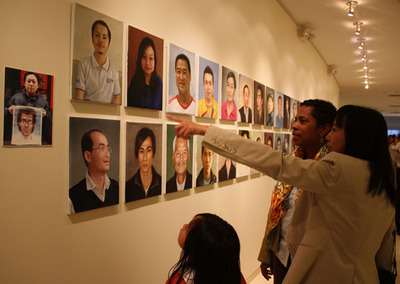'Looking Both Ways' at the 'Made in China' label and 9/11 fears

One of the curators, art historian Wen-Chien Cheng, shows Wasentha Young John C. Gonzalez’s “Self-portrait project” at the opening reception of Eastern Michigan University's “Looking Both Ways” art exhibit.
Frances Kai-Hwa Wang | Contributor
The wall of 52 faces at the Eastern Michigan University (EMU) Looking Both Ways contemporary art exhibit is striking.
The styles are all different — formal, casual, realistic, cartoonish, playful, even black and white and fake-photoshopped. There are old men and young women, hipster rock stars and craggy-faced workers. There is a high mandarin collar, a hooded sweatshirt, a tie, a baseball cap, spiky dyed hair, a cigarette.
One of the three curators, EMU art education professor Guey-Meei Yang, explains that these are the real people who work at an art factory in Dafen, China. Their job is to paint to order, whatever you want—A painting of your family or a Vincent Van Gogh. Normally prized for their technical precision, self-expression is not particularly valued, and the artists remain invisible behind factory walls.
Then John C. Gonzalez from the School of the Museum of Fine Arts, Boston, made an unusual order—a self-portrait of every artist who worked in that art factory, in any style. Together, they are a powerful illustration of the real people behind the “Made in China” label.
Ann Arbor-based Taiwan-born Chinese American artist Yuling Chuang Bruya's painting eloquently shows how she misses the idea of old China when she is in Taiwan and how she misses the Taiwan of her youth when she is in China.
Organized by Eastern Michigan University’s Art Department in partnership with University of Michigan Confucius Institute and North Campus Research Complex (NCRC) Art Program, this exhibition coincides with the 100th anniversary of the Xinhai Revolution and the founding of the Republic of China (ROC). It features artists from the United States, Taiwan, and mainland China who “provide differing critical viewpoints on the history of the ROC and its political and social-economic relationships with the People’s Republic of China (PRC) and the United States.” It runs until October 21 at two locations, NCRC and EMU University Gallery.
The Ann Arbor Chinese Center of Michigan, which is primarily geared towards heritage language learners, is expanding course offerings to include two Friday evening Chinese conversation and culture classes for people who do not speak Chinese at home—one for adults and one for children. Enrollment is brisk and everyone is welcome.
Looking into the eyes of another and engaging in their arts and learning their language are such important ways to get to know another person, another people, and to help us get past the easy labels and fears.
On September 11 last week, Frontier Airlines flight 623 from Denver to Detroit was escorted in by F-16s. Three passengers were detained and questioned for suspicious behavior, then released.
The short description seems understandable precaution at first glance, but then one of those three, Shoshana Hebshi, a self-described “half-Arab, half-Jewish housewife living in suburban Ohio,” blogged the details of her interrogation—including handcuffs, jail cell, and strip search.
What counts as “suspicious behavior” begins to look more like jittery fear of The Other.
She asks, “What is the likelihood that two Indian men who didn’t know each other and a dark-skinned woman of Arab/Jewish heritage would be on the same flight from Denver to Detroit? Was that suspicion enough? Even considering that we didn’t say a word to each other until it became clear there were cops following our plane? Perhaps it was two Indian man [sic] going to the bathroom in succession?”
At the end of her ordeal, she reports that the FBI agent told her there had been fifty other similar incidents across the country that day, “It’s 9/11 and people are seeing ghosts. They are seeing things that aren’t there.”
Let us look both ways and really see.
Note: In partnership with the Looking Both Ways exhibit, the Michigan Taiwanese American Association (MiTAI) will be holding its ninth annual Taiwanese Music Festival on Saturday, October 15, 7:00 pm, at EMU’s Student Center Auditorium featuring young musicians selected to perform select Taiwanese music after a rigorous audition process.
Frances Kai-Hwa Wang is a second-generation Chinese American from California who now divides her time between Michigan and the Big Island of Hawaii. She is an editor of IMDiversity.com Asian American Village, lead multicultural contributor for AnnArbor.com, a contributor for New America Media's Ethnoblog, and a contributor for Chicago is the World. She is on the Advisory Board of American Citizens for Justice. She team-teaches "Asian Pacific American History and the Law" at University of Michigan and University of Michigan Dearborn. She is a popular speaker on Asian Pacific American and multicultural issues. Check out her website at franceskaihwawang.com, her blog at franceskaihwawang.blogspot.com, and she can be reached at fkwang888@gmail.com.

